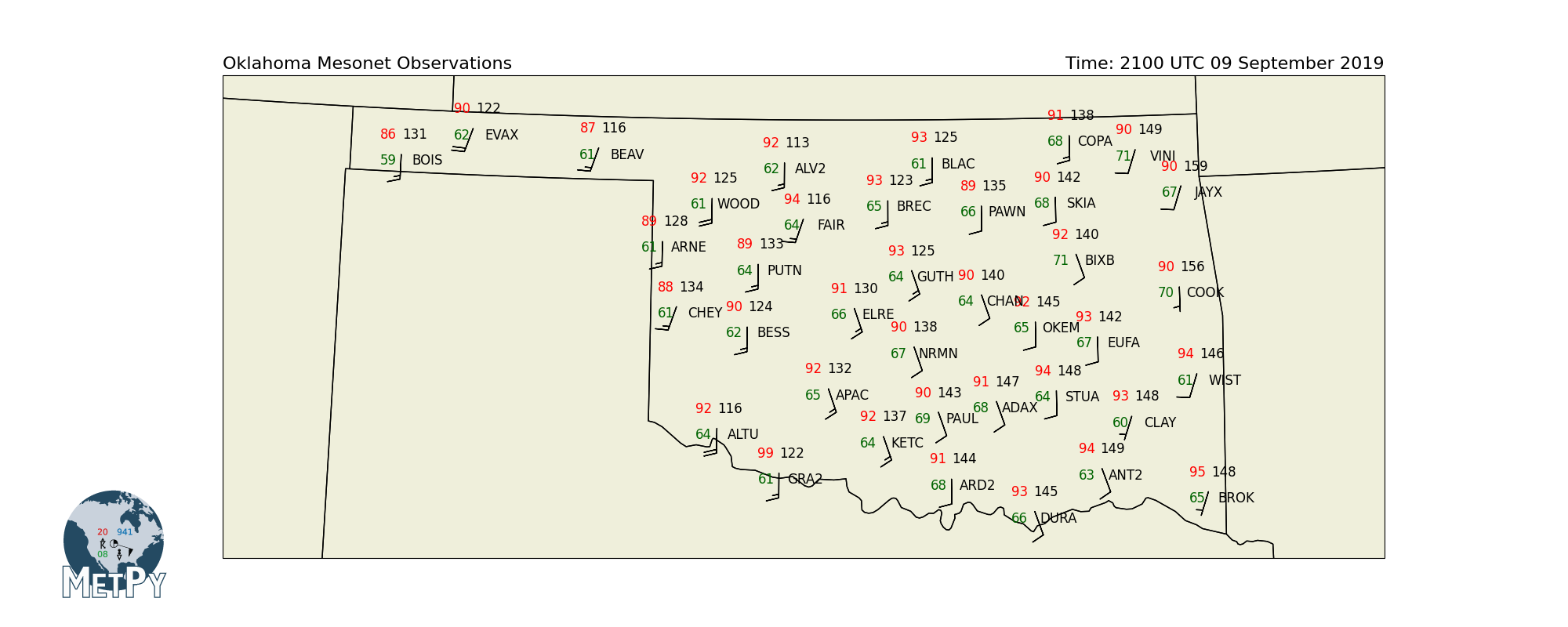Note
Click here to download the full example code
Mesonet Station Plot¶
Make a surface station plot with Oklahoma Mesonet data.
The station plot itself is pretty straightforward, but there is a bit of code to perform the data-wrangling.
import cartopy.crs as ccrs
import cartopy.feature as cfeature
import matplotlib.pyplot as plt
import pandas as pd
import metpy.calc as mpcalc
from metpy.cbook import get_test_data
from metpy.plots import add_metpy_logo, StationPlot
from metpy.units import units
Read in the data and wrangle it¶
First read in the data. We use pandas because it simplifies a lot of tasks, like dealing with strings. We’ll also convert any blank cells to NaNs, and then drop rows with NaNs in variables that we want to plot
# Current observations can be downloaded here:
# https://www.mesonet.org/index.php/weather/category/past_data_files
data = pd.read_csv(get_test_data('mesonet_sample.txt'), na_values=' ')
# Drop stations with missing values of data we want
data = data.dropna(how='any', subset=['PRES', 'TAIR', 'TDEW', 'WDIR', 'WSPD'])
The mesonet has so many stations that it would clutter the plot if we used them all. The number of stations plotted will be reduced using reduce_point_density.
# Reduce the density of observations so the plot is readable
proj = ccrs.LambertConformal(central_longitude=-98)
point_locs = proj.transform_points(ccrs.PlateCarree(), data['LON'].values, data['LAT'].values)
data = data[mpcalc.reduce_point_density(point_locs, 50 * units.km)]
Now that we have the data we want, we need to perform some conversions:
First, assign units to the data, as applicable
Convert cardinal wind direction to degrees
Get wind components from speed and direction
# Read in the data and assign units as defined by the Mesonet
temperature = data['TAIR'].values * units.degF
dewpoint = data['TDEW'].values * units.degF
pressure = data['PRES'].values * units.hPa
wind_speed = data['WSPD'].values * units.mph
wind_direction = data['WDIR']
latitude = data['LAT']
longitude = data['LON']
station_id = data['STID']
# Take cardinal direction and convert to degrees, then convert to components
wind_direction = mpcalc.parse_angle(list(wind_direction))
u, v = mpcalc.wind_components(wind_speed.to('knots'), wind_direction)
Create the figure¶
# Create the figure and an axes set to the projection.
fig = plt.figure(figsize=(20, 8))
add_metpy_logo(fig, 70, 30, size='large')
ax = fig.add_subplot(1, 1, 1, projection=proj)
# Add some various map elements to the plot to make it recognizable.
ax.add_feature(cfeature.LAND)
ax.add_feature(cfeature.STATES.with_scale('50m'))
# Set plot bounds
ax.set_extent((-104, -93, 33.4, 37.2))
stationplot = StationPlot(ax, longitude.values, latitude.values, clip_on=True,
transform=ccrs.PlateCarree(), fontsize=12)
# Plot the temperature and dew point to the upper and lower left, respectively, of
# the center point. Each one uses a different color.
stationplot.plot_parameter('NW', temperature, color='red')
stationplot.plot_parameter('SW', dewpoint, color='darkgreen')
# A more complex example uses a custom formatter to control how the sea-level pressure
# values are plotted. This uses the standard trailing 3-digits of the pressure value
# in tenths of millibars.
stationplot.plot_parameter('NE', pressure.m, formatter=lambda v: format(10 * v, '.0f')[-3:])
# Add wind barbs
stationplot.plot_barb(u, v)
# Also plot the actual text of the station id. Instead of cardinal directions,
# plot further out by specifying a location of 2 increments in x and -1 in y.
stationplot.plot_text((2, -1), station_id)
# Add title and display figure
plt.title('Oklahoma Mesonet Observations', fontsize=16, loc='left')
plt.title('Time: 2100 UTC 09 September 2019', fontsize=16, loc='right')
plt.show()

Total running time of the script: ( 0 minutes 5.476 seconds)